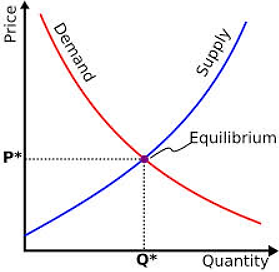SSZT918 october 2017 UCC256301 , UCC28056
According to the latest report from the World Bank, energy consumption per capita is increasing exponentially, from 1,200kWh to 3,200kWh. Although there are several driving factors behind this rise in energy consumption, a major one is the increase in the number of electronic devices per household.
Worldwide power consumption increases the need to produce more energy. The question is how to meet this demand for more energy, and the answer lies within the very simple law of economics: supply and demand, as shown in Figure 1.
 Figure 1 Supply-demand Curve
Figure 1 Supply-demand CurveThere are two choices:
- Increase the supply: Have electricity companies continue to produce more energy.
- Reduce the demand: Reduce the total power consumption per household by having every electronic device in a household consume less power.
While increasing supply seems to be a simple solution, most countries are leaning toward the second option: reducing demand, which would in turn preserve consumption of our natural resources and keep the earth green. Several countries and American states are introducing energy standards like Code of Conduct (CoC) Tier 2, U.S. Department of Energy (DoE) Level VI and California Title 22.
Still, this leads to the next problem: how to control demand when the number of consumers is increasing. The solution to this problem is designing more efficient power supplies that can deliver more energy while wasting less – without creating nightmares for power-supply designers, of course. Designers are looking for a solution that can help them crank up the performance of their power supply.
TI’s inductor-inductor-capacitor (LLC) controller, the UCC256301, introduces a new patented control algorithm, hybrid hysteretic control, to up your game and achieve the industry’s lowest standby power consumption of 40mW with no load. The controller’s ultra-fast transient response enables a reduction of the buck capacitor on the power supply by almost 20%. You can minimize the power loss by rejecting most of the AC ripple, which raises the light load efficiency of the power supply above 90% at a 10% load.
TI has also released the UCC28056, a power factor correction (PFC) controller that operates as a companion to the UCC256301. This device uses a novel mixed-mode control method that improves light-load performance, enabling systems to meet important energy standards. When paired with the UCC256301, the total AC/DC power system achieves low standby power (<80mW at 230VAC), which eliminates the need for an auxiliary flyback converter. Excellent standby power performance allows the system to keep the PFC always on, simplifying system complexity without sacrificing efficiency.
By keeping the PFC always on, the system can deliver full load power instantaneously, as the LLC no longer needs to wait for the PFC bulk capacitance to charge. This design not only meets the industry’s growing pressure on performance, but does so while minimizing the number of external components.
Both the UCC256301 and UCC28056 come with a comprehensive toolkit that simplifies the design experience and leverages several form-factor reference designs.
For additional resources, design tools and technical assistance, check out these links:
- “Exceeding Modern Energy Standards with ‘Always On’ PFC and LLC Controllers (Rev. A).”
- 24V, 480W Nominal 720W Peak, >93.5% Efficient, Robust AC/DC Industrial Power Supply Reference Design.
- 80+ Platinum, 93% Efficiency, Super Transient, 450W AC/DC Reference Design with Single-Layer PCB.
- >90% Efficiency, 200W, <125mW Standby, Fast Transient, Desktop PC PSU Reference Design.
- Less than 90mW Ultra-Low Standby Power Auxless AC/DC Power Supply Reference Design.
Learn about the basis of hybrid hysteretic control, view a comparison with other LLC controllers and follow a step-by-step guide on getting started with the UCC256301 evaluation module (EVM) with these LLC controller training videos:
- “How to get started with the UCC256301 LLC Resonant Controller EVM.”
- “Is your LLC resonant controller an underachiever?"
Learn the basics of PFC, view topology comparisons and understand the most important design considerations for a cost-effective and efficient PFC design with these PFC controller training videos: